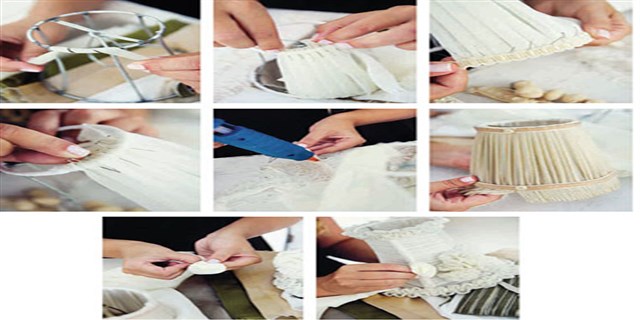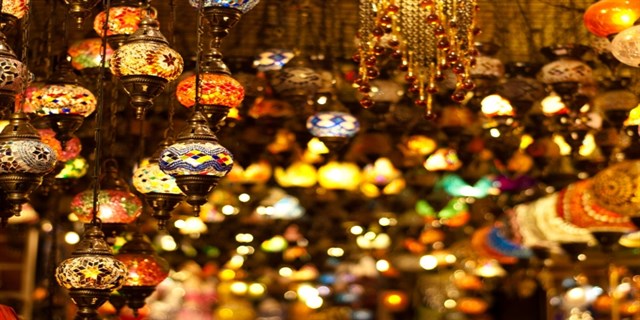Decorating Home With Lights and Lampshades… The majority of decorative plans are incomplete without a few final flourishes to complement and enhance the finish.
Lighting, wall decorations, shelving, and soft furnishings can all be used for this purpose. Many such items have a mainly ornamental function, allowing you to indulge in personal taste and add individuality to your decorative style.
Lights and Lampshades: Considering Options
It is up to you how much you accessorize, but you will need to take certain factors into account when making any decisions. You can usually achieve the desired effect in a number of ways, and which one you should choose may depend on the function of a particular room.
Displaying Items: Adding interest Create an inviting atmosphere in areas of the home used for recreation by hanging wall decorations and by displaying ornaments and other interesting items.
Safety: When carrying out any of the tasks outlined in this chapter, be sure to take appropriate safety precautions.
Electricity
• Do not allow anyone other than a fully trained, qualified electrician to carry out electrical work.
• Pipes and wires: These are usually visible but may run behind a wall surface. Check for pipes and wires before hanging pictures and mirrors.
• Fire hazards: Choose fire-retardant materials, or have their surfaces treated.
• Harmful substances: Some products contain harmful substances that must not touch the skin or be inhaled. Follow manufacturers’ guidelines.
Using Lots of Items Minimizing Extras
Providing variety: A clutter of ornaments and other items can be used to create a comfortable, homely feel. Leave space to move, and do not use too many colors. Here, warm, natural woods balance cool blues.
Creating harmony
In a bedroom, keep ornaments and other items to a minimum, and harmonize colors for a restful feeling. Here, for example, matching covers and cushions, create a harmonious atmosphere.
Taking Time:
Building up a style: Do not rush to add the finishing touches to a room. Once the main decorating has been completed, you can introduce further additions over time.
Using Understatement:
Choosing carefully: In a minimalist decorative plan, keep the accessories to a minimum also. Finishing touches will be conspicuous, so select them very carefully.
Lighting
Lighting does far more than just produce light. It is one of the most influential tools for creating mood and atmosphere in a room, and there is an extensive range of options to choose from to achieve the effects you like.
Lighting Types
Although styles of lighting vary considerably, there are only a few categories – based largely on function – into which the majority of lighting systems fall. Within these groups, designers have excelled in producing lighting to suit all tastes, and lighting styles and fashions contribute greatly to the overall decorative look of a room.
Energy-efficient Types of Lightbulb
Energy-efficient lightbulbs produce an attractive light and last up to five times longer than conventional bulbs.
Fluorescent Substitute these for standard domestic bulbs. Tungsten-halogen These are low-voltage with specially built fixtures. Choose them for powerful yet unobtrusive lighting, such as in a kitchen.
Fixed Lighting
Most rooms have some fixed lighting, which is usually operated by switches located close to a door or entrance. In spite of this relatively limited setup, there are numerous ways in which fixed lighting can be adapted in order to achieve more interesting light effects.
Choosing Lights
Changing pendant lights
Consider changing a pendant light fixture to sunken or track-mounted spotlights. These can totally change a room’s mood.
• Lighting alcoves: Fixed lighting is ideal for showing off room features and displays. Bringing in new electrical cables might necessitate redecoration, so consider battery-powered lighting, especially for occasional use.
• Diffusing light: Paint and suspend a metal colander from the base of a lampshade. It will channel the light into many shafts, creating shadows and varied intensity of light.
Making a Strip-light Diffuser
• Cut some wallpaper to size and strengthen it by taping lengths of wire across it. Fold the long edges of wallpaper to form two flaps, and attach the touch-and-close tape to them.
• Attach lengths of touch and close tape above and below the light. Gently bend the wired wallpaper to form a half-cylinder. Position it around the light and fasten the tape.
Directional Lighting
Directing light can significantly enhance the decorative style in a room or highlight specific features and thereby create a localized area of special interest. Directional lighting is also useful when you are reading or for work purposes, and therefore serves a dual function.
Focusing Light
Creating a specific effect: Use up-lighters to draw the eye upward, increasing the “height” of a room. Ensure that the ceiling is very well decorated, however, since concentrated light will highlight imperfections.
Mixing Style And Function
Choose bedside lighting that is atmospheric but also allows you to read adequately. An extending base on this wall light enables you to direct light and fits well in a modern decorative style.
Adapting Lighting
• Using dimmers: Vary the intensity of directional light by using dimmer switches. These can be installed relatively inexpensively and will enable you to increase or decrease the amount of light in a room by a simple turn of the switch.
• Hiding lights: Blend lights into their surroundings to create a harmonious and relaxing effect. For example, paint opaque bowl wall lights to match the wall color,
• Using spotlights: These provide the most adaptable form of directional lighting since you can point them in any direction. Change the emphasis of lighting within a room by occasionally altering the direction of the spotlights.
Lampshades
Once you have chosen your light fixtures, consider how lampshades will affect the kind of light produced and the coordination of lighting with other decorative features. You can buy a shade as part of a lighting system or make or adapt your own for a personal note.
Contrasting Shades Enhancing Shades
Using different colors: As in all aspects of decor, the color of a lamp and its shade will affect the atmosphere and style of a room. Use strongly contrasting colors to make a localized decorative statement.
Introducing Shapes
• Add interest to plain lamps and shades by adapting their designs. For example, cut simple patterns or shapes into a lampshade, perhaps linking to other designs and motifs within the room.
• Making holes: A hole punch intended for the paper will not cut lampshade material adequately, so use a leather punch to make however many holes you need.
Using Lampshades
• Directing light: Line a lampshade with dark paper to channel light through the bottom and top openings and therefore create concentrated, directional shafts of light.
• Varying color: Alter the effect of a lampshade by using a colored lightbulb. This will have a dramatic effect if you are using a pale lampshade and allow you to experiment with color and a dark shade.
• Keeping clean: To ensure that a lampshade looks at its best, always keep it clean. Either vacuum it using the appropriate attachment or wrap sticky tape around your hand (sticky-side out) and brush over the surface of the shade to pick up dust and dirt.
• Choosing threads: Once you have made the holes, change the ribbon or thread.
Decorating Shades
• Attaching stickers Stick shaped, fluorescent stickers onto a plain lampshade. Once they have absorbed light while the lamp is on, they will continue to shine after it has been turned off. This is a particularly good idea in a child’s bedroom.
• Stenciling designs Coordinate lampshades with the rest of the decoration in a room by stenciling the same design on the shade as there is on a border, for example.
• Using a wallpaper border Cut down a wallpaper border to make a mini-border, then attach it around the edges of color-coordinating shades.
• Adding trimmings Use contrasting or matching braids, tassels, or other appropriate trimmings to enhance the lower edge of a plain shade.
Threading a Shade With Decorative Strands
• Use a pencil to make a series of equidistant marks around the upper and lower edges of a lampshade. Make holes at these marks using a leather punch, holding the shade firmly as you do so.
• Pass some ribbon through the holes, making a criss¬cross pattern over the surface of the lampshade. Create any number of your own designs using the same method and a variety of alternative materials.






